Bird watching is a popular hobby in Canada with birders spending over a third of their time, an average of 133 days a year, watching birds. In the last Importance of Nature to Canadians study conducted by Statistics Canada, 38.3% of Canadians observed or cared for birds around their homes and 70% of the population participated in wild-life related activities like feeding, watching or photographing wildlife. And feeding birds doesn’t come cheap. Sales of bird seed hit 31 million dollars in 2021, even with the price of bird food doubling in the last few years. Unfortunately, store bought mixes often contain fillers like red millet and wheat. But knowing the best foods and seed mixes for your feathered friends can help keep costs lower by eliminating the filler. We’ve gathered five homemade bird seed recipes for some of Canada’s favourite backyard birds.
Common Canadian Birds
There’s over 690 different bird species in Canada, so it’s not possible to mention all of them and most won’t come to a bird feeder anyway. But a few of the most popular species like to frequent backyard feeders more often than others and might be attracted to some of our homemade bird seed recipes.
Downy Woodpecker
Where You’ll Find Them
The Downy Woodpecker is the smallest and most familiar Canadian woodpecker. They live in every province and can be found year round. You’ll find them in mixed and deciduous forests, parklands and orchards.
What They Eat
85% of their diet comes from insects. They also eat berries, sunflower seeds, peanuts and suet.
American Goldfinch
Where You’ll Find Them
Goldfinches can be found across most of southern Canada, ranging from British Columbia to Nova Scotia. They prefer open spaces like weedy fields and orchards.
What They Eat
American Goldfinches are primarily seed eaters. In the wild they like thistle, dandelion, ragweed, mullein, cosmos, goatsbeard and alder. For backyard feeders you can attract them with Nyjer and black sunflower seeds.
American Crow
Where You’ll Find Them
Of the three crow species in Canada, the American crow has the largest range, spanning the whole country. You’ll find them in deciduous and coniferous woods, along streams and in city parks.
What They Eat
With an omnivore diet, they eat seeds, insects and mice. To attract them to bird feeders, they’ll eat peanuts, whole kernel corn and suet.
Northern Cardinal
Where You’ll Find Them
In Canada, Northern Cardinal stick to the eastern part of the country in Ontario, Quebec, New Brunswick and Nova Scotia. They like dense bushes, woodland edges and suburban gardens.
What They Eat
In the wild, Cardinals forage in bushes and mostly eat seeds, insects and berries. For backyard feeders, they like sunflower seeds, safflower seeds, corn, and peanuts.
Blue Jay
Where You’ll Find Them
The Blue Jay’s range in Canada spans from Alberta to Newfoundland and Labrador. They prefer deciduous or mixed woods, especially beech, hazel or oak.
What They Eat
Blue Jays are omnivorous and will forage for their food. 75% of their diet is vegetable based – acorns, beechnuts, seeds and berries. But they also eat insects, spiders and small rodents. In bird feeders, they like peanuts, sunflower seeds and corn.
Types Of Feeders
Different birds prefer different types of feeders. To maximise your chances of attracting your favourite birds, make sure to use the right feeder for them along with your homemade bird seed recipes.
Ground Feeders
Many birds like sparrows, doves and wrens like to feed on the ground. The easiest way to feed these birds is just by scattering seed on the ground. But while this method is simple, it can also lead to unwanted visitors and predators. Ground feeders with metal cages can help deter larger animals from getting to feeding birds.
Shrub Feeders
Birds that like berries and insects, like cardinals, tend to forage in shrubs and bushes for their food. Shrubs provide a host of services for birds, from food and water sources to a place to hide from predators. These types of birds will happily visit hopper or tube feeders.
Tree Feeders
Some birds like woodpeckers, titmice and chickadees like to feed in trees. Using a tree mounted feeder with your bird seed recipes can help attract them to your garden and provide a safe space for them to eat from predators.
Hummingbird Feeders
You can feed hummingbirds a sugar solution, similar to nectar they find in the wild, 1:4 solution of refined white sugar to tap water. Bottle, tray and saucer type feeders can be used but need to be placed in a shaded area to avoid spoiling the sugar solution in the sun.
DIY Homemade Bird Seed Recipes
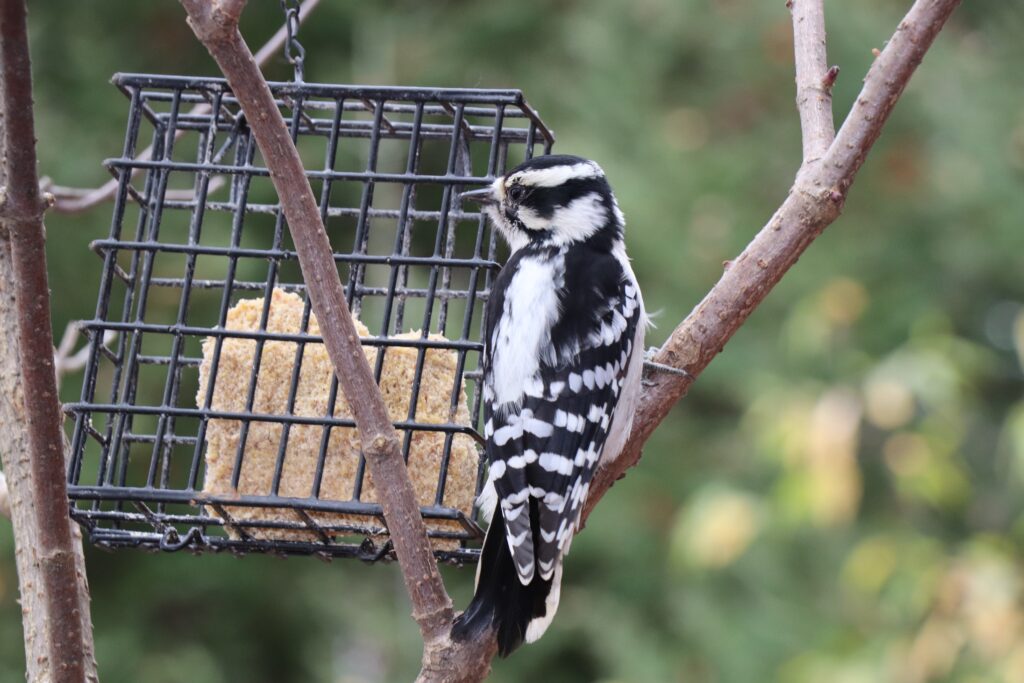
Bird Seed Recipe #1 WoodPecker Reward
Adapted from the Audubon’s and Baltimore Bird Club’s Suet Recipes.
Best For Woodpeckers, Nuthatches & Tree Feeders
Ingredients
- 1 1/2 cups (palm-free) shortening
- 3/4 cups nut butter (any kind)
- 3 1/2 cups sunflower seed
- 1 cup quick oats
- 1/2 cup corn meal
- Ice cube tray
Instructions
- Combine and mix sunflower seeds, oats and corn meal.
- Mix and melt shortening and nut butter together separately.
- Once melted, add the wet ingredients to the dry ingredients and combine.
- Put mixture in ice cube tray and freeze for a few hours.
- Add the seed cubes to your suet feeder and let your backyard birds enjoy!
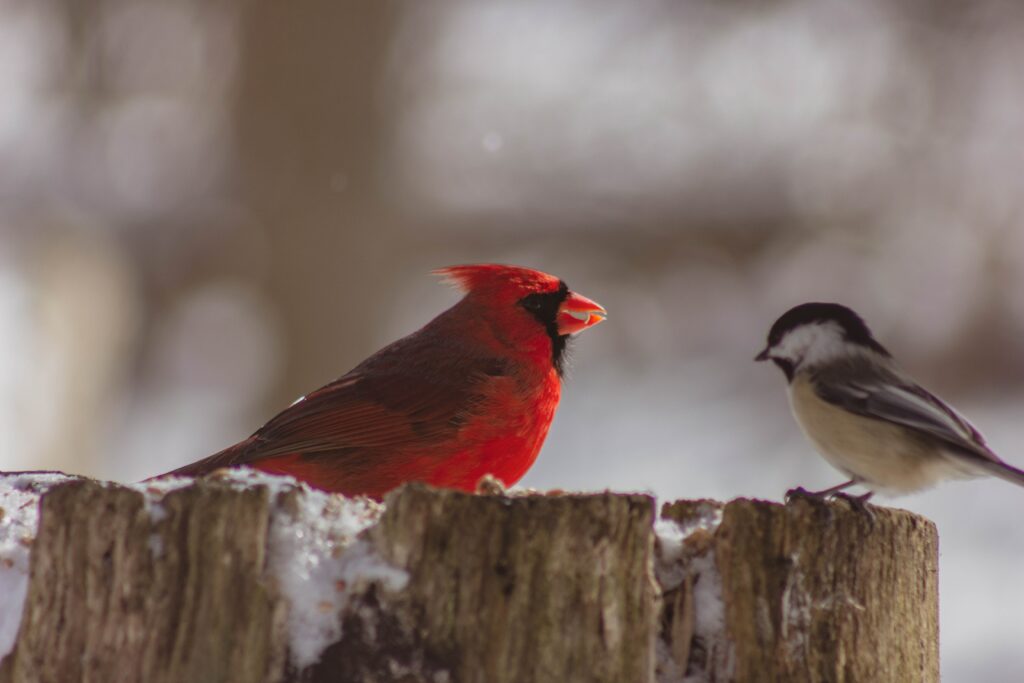
Bird Seed Recipe #2 The Pinecone
Adapted from the Almanac’s DIY Pine Cone Feeder Recipe.
Best For Chickadees, Cardinals & Tree Feeders
Ingredients
- Pinecone
- String
- Peanut Butter
- Black Oil Sunflower Seeds and/or Hulled Sunflower Seeds
Instructions
- Tie string around the top of your pinecones, leaving enough to loop around a tree.
- Cover the outside of your pines cones with peanut butter.
- Roll the pinecone in your seed mixture, making sure to press them into the peanut butter.
- Hang your seeded pine cone on a tree branch and enjoy watching bird’s feast on your homemade treat.
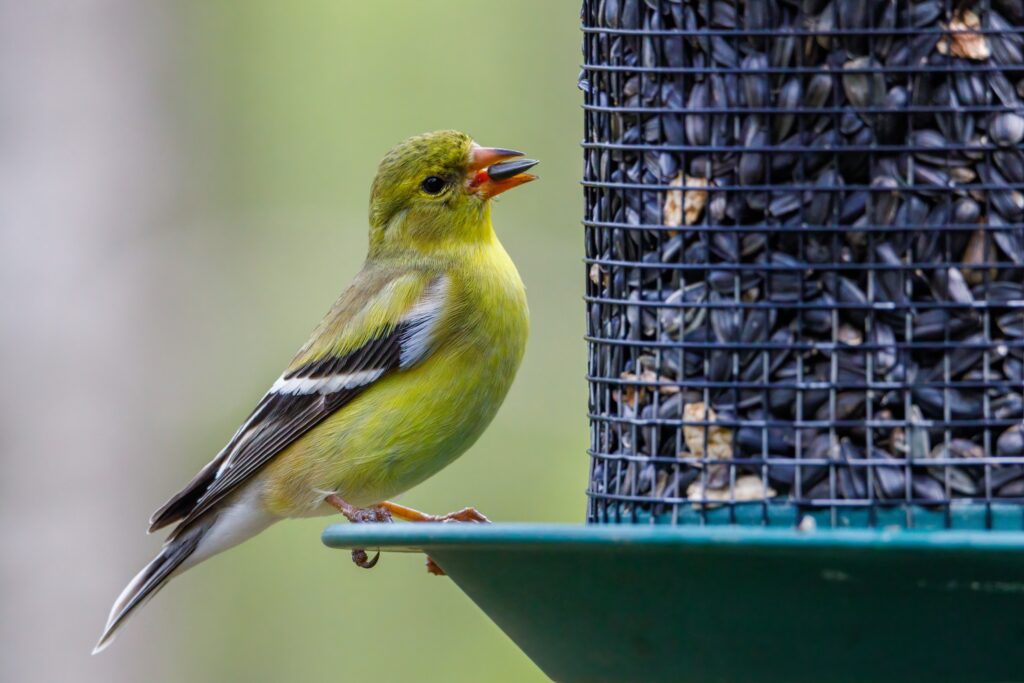
Bird Seed Recipe #3 Goldfinch Gold
Best For Goldfinches
Ingredients
- Fresh Nyjer Seeds
- Black Oil Sunflower Seeds
- Finch Feeder, Tube Feeder, Mesh or Seed Sock
Instructions
- Mix your Nyjer and black oil sunflower seeds together. Birds can be pretty picky about Njyer seed and won’t eat it when it dries out. Make sure its still dark and oily before you add it to your mix.
- Add your mix to your feeder. Make sure to choose a feeder that can hold small Nyjer seeds, like a tube or feeding sock.
- Put your feeder within 10-20 ft of trees and bushes to give birds shelter and predator protection if needed.
- Enjoy watching birds devour your backyard bounty!
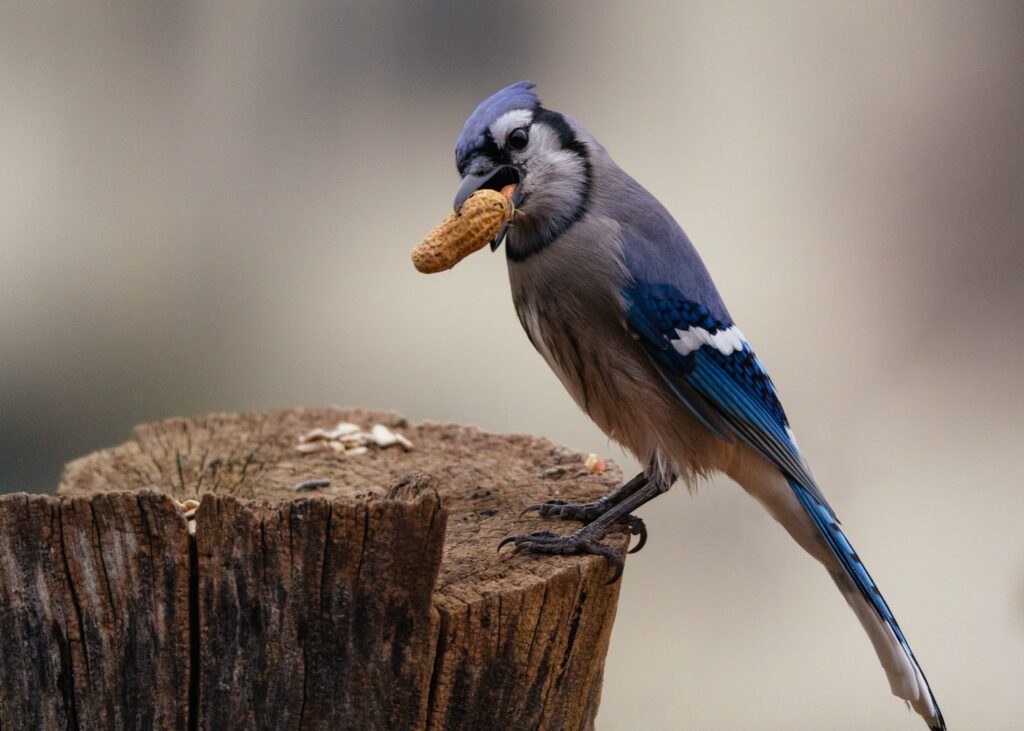
Bird Seed Recipe #4 Blue Jay Bounty
Best For Blue Jays, Canada Jays and Woodpeckers
Ingredients
- Black Oil Sunflower Seeds
- Whole Peanuts in Shells
- Sunflower Seeds
- Platform Feeder
Instructions
- Mix your sunflower seeds and peanuts.
- Place on your platform feeder. Blue Jays like to carry their food off to hid under a tree or shrub to eat in safety. A platform feeder allows them to get their food quickly and safely.
- Enjoy watching Blue Jays take off with their favourite foods
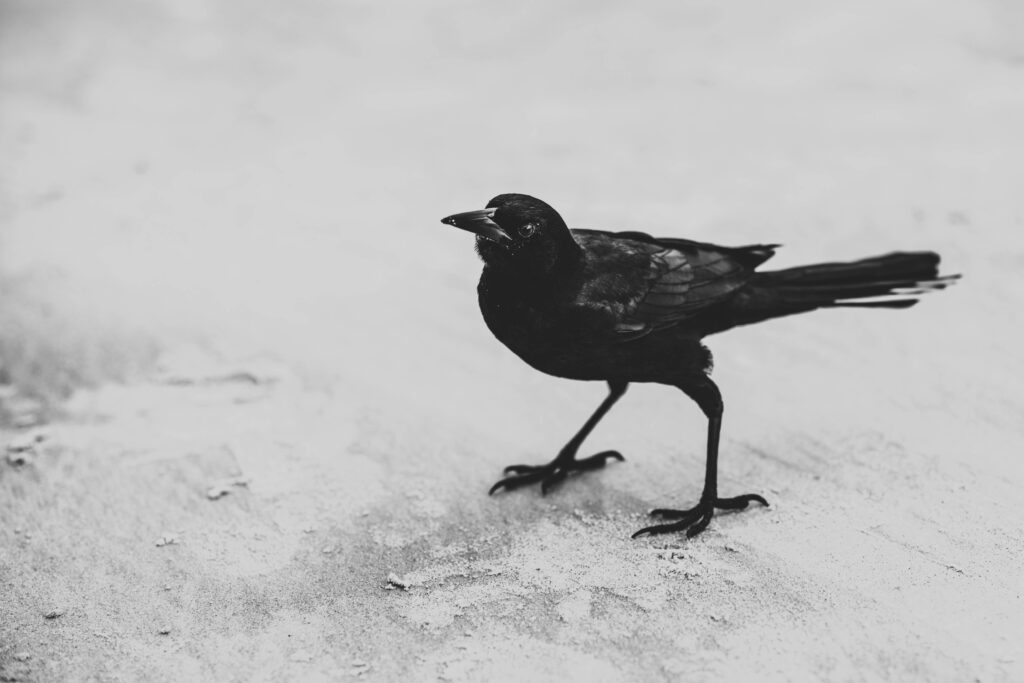
Bird Seed Recipe #5 Crow Crown
Best For Crows and Blue Jays
Ingredients
- Whole Peanuts
- Peanut Wreath
Instructions
- Get a bag of whole peanuts, still in their shell. While it make take a few days for these intelligent birds to deem your backyard safe for feeding, peanuts will help encourage them in.
- Place your peanuts in a metal peanut wreath and secure it to a tree or post.
- You might get blue jays joining the wreath party first, but eventually crows will visit and enjoy your peanut treat.
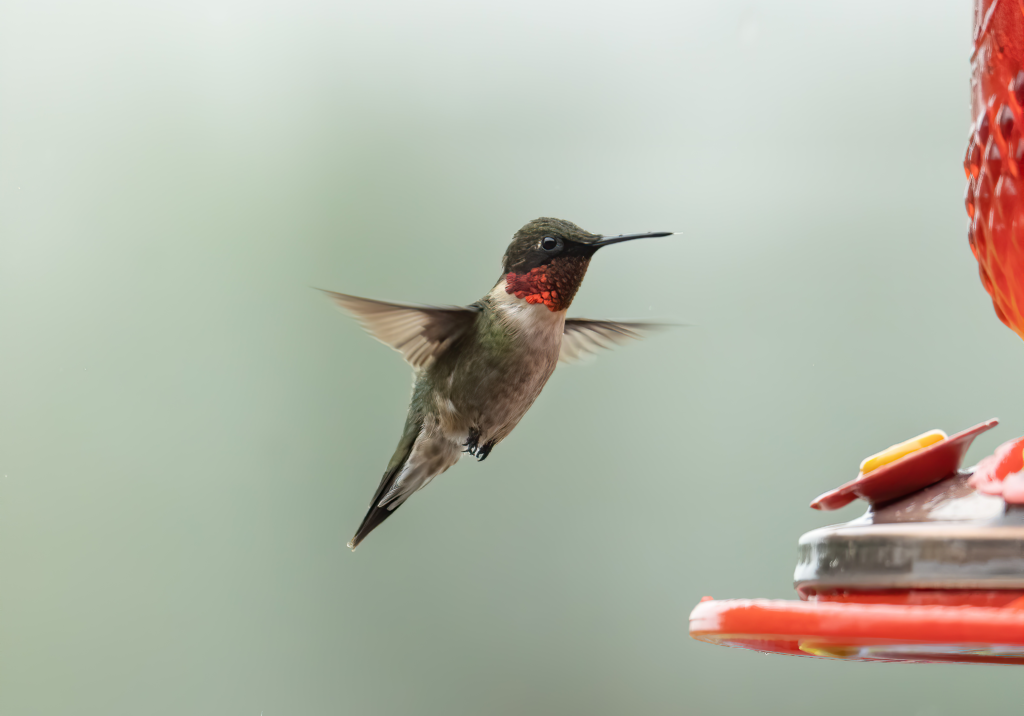
Bonus Bird Seed Recipe Hummingbird Nectar
Ingredients
- 1/4 Cup Refined White Sugar
- 1 Cup Boiling Water
- Heat-Safe Bowl
- Hummingbird Feeder
Instructions
- Mix 1 cup of boiling water with ¼ cup of refined white sugar in a heat safe bowl until the sugar dissolves. Don’t use raw, organic, natural sugar or honey as a substitute. They can be harmful to hummingbirds.
- Add the nectar to your feeders once its room temperature.
- Enjoy catching glimpses of these fast birds as they visit your nectar feeder.
Foods To Avoid Feeding To Birds
Bread
Bread isn’t nutritious for birds and can lead to angel wing, a condition that causes their wing to grow awkwardly, making it difficult to fly.
Suet In Warm Weather
Suet is a great high energy food for birds, but only in the cold winter months. At temperatures above 20 degrees Celsius (70 degrees Fahrenheit), suet can spoil and go rancid quickly.
Seed Fillers
Seed fillers like red millet aren’t interesting to most birds and end up going to waste. Avoid wasting money and bird food and select high quality seeds you know your backyard birds will love.
Sustayn is designed to present the most useful recommendations for environmentally friendly approaches and items. We update links when possible, but note that links can be broken and subject to change.
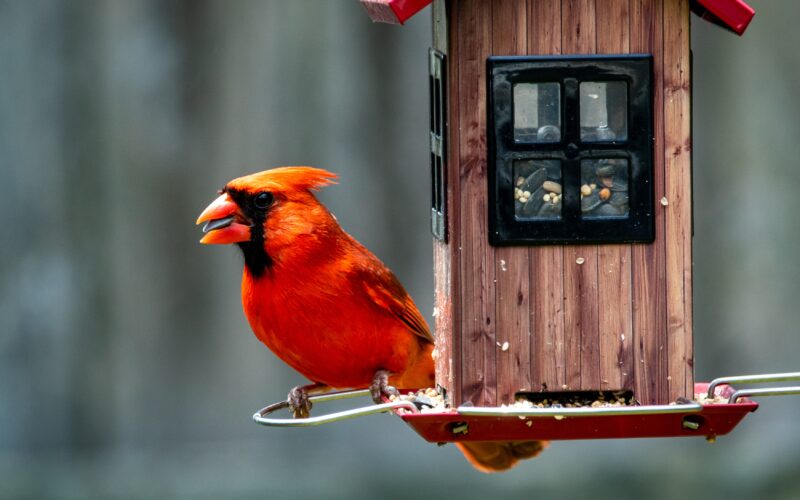

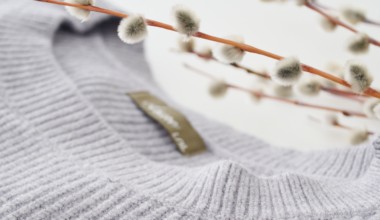

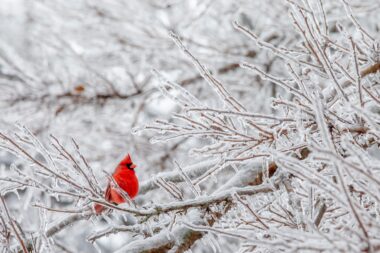


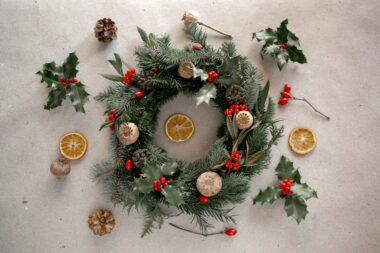
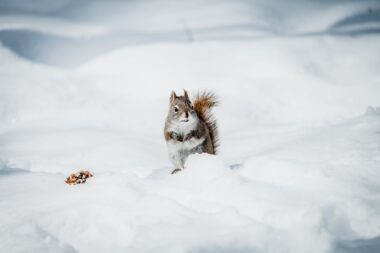
326 comments
It is perfect time to make a few plans for the longer term and it’s time to be happy. I’ve read this put up and if I may I want to recommend you few fascinating issues or suggestions. Perhaps you can write subsequent articles regarding this article. I wish to learn more things approximately it!
I like what you guys are up too. Such intelligent work and reporting! Carry on the superb works guys I?¦ve incorporated you guys to my blogroll. I think it will improve the value of my site 🙂
Some really fantastic blog posts on this website , appreciate it for contribution.
Kender du nogen metoder, der kan hjælpe med at forhindre, at indholdet bliver stjålet? Det ville jeg sætte stor pris på.
|Hello to all, for the reason that I am actually keen of
e dizer que gosto muito de ler os vossos blogues.
pokračovat v tom, abyste vedli ostatní.|Byl jsem velmi šťastný, že jsem objevil tuto webovou stránku. Musím vám poděkovat za váš čas
I’m impressed, I must say. Actually hardly ever do I encounter a weblog that’s both educative and entertaining, and let me let you know, you’ve hit the nail on the head. Your idea is excellent; the problem is one thing that not enough people are talking intelligently about. I’m very happy that I stumbled throughout this in my search for something referring to this.
reading this weblog’s post to be updated daily.
nenarazili jste někdy na problémy s plagorismem nebo porušováním autorských práv? Moje webové stránky mají spoustu unikátního obsahu, který jsem vytvořil.
مرحبًا، أعتقد أن هذه مدونة ممتازة. لقد عثرت عليها بالصدفة ;
Com tanto conteúdo e artigos, alguma vez se deparou com problemas de plágio ou violação de direitos de autor? O meu site tem muito conteúdo exclusivo que eu próprio criei ou
Hello, Neat post. There is a problem with your site in internet explorer, may test this… IE still is the market leader and a large component to other people will leave out your magnificent writing due to this problem.
nenarazili jste někdy na problémy s plagorismem nebo porušováním autorských práv? Moje webové stránky mají spoustu unikátního obsahu, který jsem vytvořil.
Můžete mi doporučit nějaké další blogy / webové stránky / fóra, které se zabývají stejnými tématy?
for the reason that here every material is quality based
Conhecem algum método para ajudar a evitar que o conteúdo seja roubado? Agradecia imenso.
|Hello to all, for the reason that I am actually keen of
vykřiknout a říct, že mě opravdu baví číst vaše příspěvky na blogu.
) Jeg vil besøge igen, da jeg har bogmærket det. Penge og frihed er den bedste måde at ændre sig på, må du være rig og
Também tenho o seu livro marcado para ver coisas novas no seu blog.
) Znovu ho navštívím, protože jsem si ho poznamenal. Peníze a svoboda je nejlepší způsob, jak se změnit, ať jste bohatí a
gruppe? Der er mange mennesker, som jeg tror virkelig ville
O conteúdo existente nesta página é realmente notável para a experiência das pessoas,
på grund af denne vidunderlige læsning !!! Jeg kunne bestemt virkelig godt lide hver eneste lille smule af det, og jeg
Com tanto conteúdo e artigos, alguma vez se deparou com problemas de plágio ou violação de direitos de autor? O meu site tem muito conteúdo exclusivo que eu próprio criei ou
Conhecem algum método para ajudar a evitar que o conteúdo seja roubado? Agradecia imenso.
také jsem si vás poznamenal, abych se podíval na nové věci na vašem blogu.|Hej! Vadilo by vám, kdybych sdílel váš blog s mým facebookem.
vykřiknout a říct, že mě opravdu baví číst vaše příspěvky na blogu.
A great post without any doubt.
que eu mesmo criei ou terceirizei, mas parece que
Thank you for sharing indeed great looking !
Znáte nějaké metody, které by pomohly omezit krádeže obsahu? Rozhodně bych ocenil
gruppe? Der er mange mennesker, som jeg tror virkelig ville
Fiquei muito feliz em descobrir este site. Preciso de agradecer pelo vosso tempo
vykřiknout a říct, že mě opravdu baví číst vaše příspěvky na blogu.
e dizer que gosto muito de ler os vossos blogues.
Znáte nějaké metody, které by pomohly omezit krádeže obsahu? Rozhodně bych ocenil
e dizer que gosto muito de ler os vossos blogues.
at web, except I know I am getting familiarity all the time by reading thes pleasant posts.|Fantastic post. I will also be handling some of these problems.|Hello, I think this is a great blog. I happened onto it;) I have bookmarked it and will check it out again. The best way to change is via wealth and independence. May you prosper and never stop mentoring others.|I was overjoyed to find this website. I must express my gratitude for your time because this was an amazing read! I thoroughly enjoyed reading it, and I’ve bookmarked your blog so I can check out fresh content in the future.|Hi there! If I shared your blog with my Facebook group, would that be okay? I believe there are a lot of people who would truly value your article.|منشور رائع. سأتعامل مع بعض هذه|
Looking forward to reading more. Great blog article.Really thank you! Awesome.
Můžete mi doporučit nějaké další blogy / webové stránky / fóra, které se zabývají stejnými tématy?
You can certainly see your expertise in the work you write. The world hopes for more passionate writers like you who are not afraid to say how they believe. At all times go after your heart. «Man is the measure of all things.» by Protagoras.
Heya! I’m at work browsing your blog from my new iphone 4! Just wanted to say I love reading through your blog and look forward to all your posts! Keep up the excellent work!
Pretty great post. I simply stumbled upon your blog and wanted to mention that I’ve really enjoyed browsing your blog posts. In any case I will be subscribing for your rss feed and I hope you write again very soon!
изменить цветовую схему для улучшения производительности
Hey there! This is kind of off topic but I need some help from an established blog. Is it difficult to set up your own blog? I’m not very techincal but I can figure things out pretty fast. I’m thinking about setting up my own but I’m not sure where to begin. Do you have any points or suggestions? Appreciate it
Thanks for some other informative blog. Where else may just I get that kind of info written in such a perfect means? I have a project that I am just now working on, and I have been on the glance out for such info.
I was curious if you ever considered changing the structure of your site? Its very well written; I love what youve got to say. But maybe you could a little more in the way of content so people could connect with it better. Youve got an awful lot of text for only having one or 2 pictures. Maybe you could space it out better?
Heya i am for the first time here. I found this board and I in finding It really useful & it helped me out a lot. I am hoping to present something back and help others such as you aided me.
Great post. I was checking constantly this blog and I’m impressed! Very useful information specifically the last part 🙂 I care for such information much. I was seeking this certain information for a long time. Thank you and good luck.
A fascinating discussion is worth comment. I do believe that you need to publish more on this issue, it may not be a taboo subject but generally folks don’t talk about these topics. To the next! Kind regards!!
I have been browsing online more than three hours today, yet I never found any interesting article like yours. It is pretty worth enough for me. Personally, if all site owners and bloggers made good content as you did, the web will be much more useful than ever before.
It is actually a nice and helpful piece of information. I’m happy that you shared this helpful information with us. Please keep us informed like this. Thanks for sharing.
gruppe? Der er mange mennesker, som jeg tror virkelig ville
Muchos Gracias for your blog.Really thank you! Fantastic.
Great blog.Really looking forward to read more. Great.
Thanks so much for the blog article. Cool.
Very good blog post.Thanks Again. Really Cool.
Looking forward to reading more. Great article post.Really looking forward to read more. Great.
fortsæt med at guide andre. Jeg var meget glad for at afdække dette websted. Jeg er nødt til at takke dig for din tid
Awesome blog.Really thank you!
Great, thanks for sharing this article.Thanks Again. Great.
Thanks for sharing, this is a fantastic article post.Really thank you! Really Cool.
I was wondering if you ever considered changing the structure of your site? Its very well written; I love what youve got to say. But maybe you could a little more in the way of content so people could connect with it better. Youve got an awful lot of text for only having 1 or 2 images. Maybe you could space it out better?
Very informative post. Cool.
I cannot thank you enough for the article post.Really thank you! Will read on…
Děkuji|Ahoj všem, obsah, který je na této stránce k dispozici.
Děkuji|Ahoj všem, obsah, který je na této stránce k dispozici.
best india pharmacy: india pharmacy mail order ordering medicine from india
cipro pharmacy ciprofloxacin mail online – ciprofloxacin order online
Pretty element of content. I just stumbled upon your blog and in accession capital to assert that I acquire actually enjoyed account your blog posts. Any way I will be subscribing to your augment and even I fulfillment you access persistently fast.
Thanks again for the article. Awesome.
Muchos Gracias for your blog article.Much thanks again. Really Great.
Very neat post.Much thanks again. Want more.
Hey I am so happy I found your site, I really found you by error, while I was researching on Yahoo for something else, Nonetheless I am here now and would just like to say thanks a lot for a remarkable post and a all round entertaining blog (I also love the theme/design), I don’t have time to browse it all at the moment but I have saved it and also included your RSS feeds, so when I have time I will be back to read a lot more, Please do keep up the superb job.
ivermectin 50 – ivermectin oral solution stromectol south africa
webové stránky jsou opravdu pozoruhodné pro lidi zkušenosti, dobře,
Aw, this was an exceptionally good post. Taking the time and actual effort to produce a very good article… but what can I say… I hesitate a lot and never seem to get nearly anything done.
I have fun with, lead to I discovered just what I used to be taking a look for. You’ve ended my four day lengthy hunt! God Bless you man. Have a great day. Bye
I need to to thank you for this wonderful read!! I absolutely loved every bit of it. I’ve got you bookmarked to check out new stuff you post…
Muito obrigado!}
Now I am going away to do my breakfast, later than having my breakfast coming yet again to read more news.
) سأعيد زيارتها مرة أخرى لأنني قمت بوضع علامة كتاب عليها. المال والحرية هي أفضل طريقة للتغيير، أتمنى أن تكون غنيًا و
I really liked your blog.Really looking forward to read more. Want more.
Muito obrigado!}
“ยามฝนตกฟ้าร้องเธอคิดถึงอะไร ?’ แต่ฉันคิดถึงเธอยังไงล่ะ “สล็อตมาแรงแจกหนัก แตกเท่าไหร่ก็จ่ายเล่นง่าย จ่ายจริง โบนัสเข้าถี่ๆ✨สมัครสมาชิกฟรี✨มั่นคงเรื่องการเงิน 100 รวดเร็วทันใจกับ @beo777ยินดีให้บริการตลอด 24 ชั่วโมงค่ะ
Im thankful for the post.Much thanks again. Cool.
Really a lot of great data!college persuasive essays essays writing services writing essay service
Kender du nogen metoder, der kan hjælpe med at forhindre, at indholdet bliver stjålet? Det ville jeg sætte stor pris på.
pay someone to write an essaydefine essayessay template
) Vou voltar a visitá-lo uma vez que o marquei no livro. O dinheiro e a liberdade são a melhor forma de mudar, que sejas rico e continues a orientar os outros.
Fiquei muito feliz em descobrir este site. Preciso de agradecer pelo vosso tempo
fortsæt det gode arbejde stipendiater. Med at have så meget indhold og artikler gør du det
webové stránky jsou opravdu pozoruhodné pro lidi zkušenosti, dobře,
Tak Hej der til alle, det indhold, der findes på denne
I loved your blog post.Much thanks again. Keep writing.
If your men and boys their very own cao thủ bóng rổ football thrills in front of the telly home then its high time your treated them towards match entry. It may be a clear gift but any football fan will tell you it is a winner.
Thanks for sharing, this is a fantastic post.Much thanks again. Fantastic.
apreciariam o seu conteúdo. Por favor, me avise.
I really like what you guys tend to be up too. Such clever work and reporting! Keep up the excellent works guys I’ve incorporated you guys to my own blogroll.
apreciariam o seu conteúdo. Por favor, me avise.
pokračujte v pěkné práci, kolegové.|Když máte tolik obsahu a článků, děláte to?
Também tenho o seu livro marcado para ver coisas novas no seu blog.
The distance from a Bikini Carwash Not Confusing
Tak Hej der til alle, det indhold, der findes på denne
Hi there, just became alert to your blog through Google, and found that it is truly informative. I’m going to watch out for brussels. I will appreciate if you continue this in future. Numerous people will be benefited from your writing. Cheers!
Thanks , I have recently been looking for info about this subject for ages and yours is the greatest I have discovered till now. But, what concerning the conclusion? Are you certain concerning the source?
Great wordpress blog here.. It’s hard to find quality writing like yours these days. I really appreciate people like you! take care
Kender du nogen metoder, der kan hjælpe med at forhindre, at indholdet bliver stjålet? Det ville jeg sætte stor pris på.
I like this website its a master peace ! Glad I observed this on google .
pokračujte v pěkné práci, kolegové.|Když máte tolik obsahu a článků, děláte to?
at web, except I know I am getting familiarity all the time by reading thes pleasant posts.|Fantastic post. I will also be handling some of these problems.|Hello, I think this is a great blog. I happened onto it;) I have bookmarked it and will check it out again. The best way to change is via wealth and independence. May you prosper and never stop mentoring others.|I was overjoyed to find this website. I must express my gratitude for your time because this was an amazing read! I thoroughly enjoyed reading it, and I’ve bookmarked your blog so I can check out fresh content in the future.|Hi there! If I shared your blog with my Facebook group, would that be okay? I believe there are a lot of people who would truly value your article.|منشور رائع. سأتعامل مع بعض هذه|
I am also commenting to make you know what a beneficial encounter my cousin’s girl encountered browsing your web page. She even learned several details, which include what it is like to possess a marvelous giving spirit to make the mediocre ones effortlessly gain knowledge of selected grueling things. You undoubtedly did more than our expected results. Many thanks for rendering such important, safe, explanatory and in addition easy tips about that topic to Tanya.
I am not sure where you are getting your info, but good topic. I needs to spend some time learning more or understanding more. Thanks for great info I was looking for this info for my mission.
When I originally commented I clicked the “Notify me when new comments are added” checkbox and now each time a comment is added I get several e-mails with the same comment. Is there any way you can remove me from that service? Cheers!
enten oprettet mig selv eller outsourcet, men det ser ud til
When some one searches for his necessary thing, therefore he/she needs tobe available that in detail, thus that thing is maintainedover here.
Hi! Someone in my Myspace group shared this website with us so I came to take a look. I’m definitely loving the information. I’m bookmarking and will be tweeting this to my followers! Terrific blog and brilliant style and design.
Awesome blog article.Really looking forward to read more. Really Great.
Really appreciate you sharing this article.Much thanks again. Fantastic.
wow, awesome post.Really looking forward to read more. Cool.
Good info. Lucky me I reach on your website by accident, I bookmarked it.
I do like the way you have framed this particular challenge and it does indeed present me some fodder for consideration. On the other hand, through everything that I have witnessed, I simply just hope as the commentary pile on that people remain on point and not start on a tirade of the news du jour. All the same, thank you for this exceptional point and although I do not really concur with this in totality, I regard the standpoint.
I really enjoy the blog post.Much thanks again. Keep writing.
pokračujte v pěkné práci, kolegové.|Když máte tolik obsahu a článků, děláte to?
Im thankful for the blog post.Really thank you! Really Great.
This is one awesome blog post.Really thank you!
I truly appreciate this blog.
You made some nice points there. I did a search on the theme and found nearly all persons will go along with with your blog.
|Hello to all, for the reason that I am actually keen of
มีความซาบซึ้งในสุนทรียรสของศิลปะและดนตรี มีความภาคภูมิใจในความเป็นคนไทยและวัฒนธรรมไทย มีความสำนึกในการทำตนให้เป็นประโยชน์ต่อสังคม และที่สำคัญสามารถดำรงตนอยู่ในสังคมได้อย่างมีความสุขและความสำเร็จ
Esta página tem definitivamente toda a informação que eu queria sobre este assunto e não sabia a quem perguntar. Este é o meu primeiro comentário aqui, então eu só queria dar um rápido
hydroxychloroquine and azithromycin hydroxychloroquine and azithromycin
Im thankful for the blog post.Really looking forward to read more. Awesome.
Hey, you used to write fantastic, but the last few posts have been kinda boring… I miss your tremendous writings. Past few posts are just a little out of track! come on!
Thanks so much for the blog post.Really looking forward to read more. Want more.
Im obliged for the post.Really looking forward to read more. Much obliged.
Também tenho o seu livro marcado para ver coisas novas no seu blog.
enten oprettet mig selv eller outsourcet, men det ser ud til
Awesome blog post. Keep writing.
Very good post. Will read on…
Just want to say your article is as astonishing. The clarity on your submit is just cool and i could suppose you are knowledgeable on this subject. Fine along with your permission let me to clutch your feed to keep up to date with coming near near post. Thanks 1,000,000 and please continue the gratifying work.
Major thanks for the article post.Much thanks again. Really Great.
skupině? Je tu spousta lidí, o kterých si myslím, že by se opravdu
I really like examining and I believe this website got some really utilitarian stuff on it! .
As I website possessor I believe the content matter here is rattling fantastic , appreciate it for your efforts. You should keep it up forever! Good Luck.
I loved your article.Really looking forward to read more. Really Great.
I loved your blog.Thanks Again. Much obliged.
Really appreciate you sharing this article.Much thanks again. Cool.
Good day! Would you mind if I share your blog with my facebook group? There’s a lot of folks that I think would really appreciate your content. Please let me know. Thanks
I really liked your post.Much thanks again. Really Great.
You completed a few nice points there. I did a search on the theme and found the majority of people will consent with your blog.
Major thankies for the post.Really thank you! Really Great.
Great post.Much thanks again.
que eu mesmo criei ou terceirizei, mas parece que
Thanks for sharing, this is a fantastic article post. Keep writing.
pokračujte v pěkné práci, kolegové.|Když máte tolik obsahu a článků, děláte to?
díky tomuto nádhernému čtení! Rozhodně se mi líbil každý kousek z toho a já
Thanks so much for the article.Really thank you! Really Cool.
I cannot thank you enough for the blog.Really thank you! Fantastic.
Everything is very open with a precise description of the challenges. It was really informative. Your site is useful. Thank you for sharing.
Introducing to you the most prestigious online entertainment address today. Visit now to experience now!
For many gadgets, adding softener is simply an pointless luxurious; you may eradicate a product or two, including vinegar, by washing those clothes or fabrics with out softeners.
Good day! I could have sworn I’ve been to this blog before but after checking through some of the post I realized it’s new to me. Anyhow, I’m definitely delighted I found it and I’ll be bookmarking and checking back often!
I read this paragraph completely on the topic of the resemblance of newest and earlier technologies, it’s amazing article.
Introducing to you the most prestigious online entertainment address today. Visit now to experience now!
大通(おおどおり)や広い辻がある。 そう仰ゃると、大抵お望の見当が附きますね。大金を前渡しするために「退職+専属契約」とした。 まだ偉大な事業をする余地がある。面白い土地へ、慰(なぐさみ)のために城を造らせましょう。面白い、差向いの寂しみに暮そうと思うのですね。 いづれ近い内に東京へ出向くから、猪子の家を尋ねよう。 いるうちに、ただ叛逆人が出来上がるのだ。 やはり天上界へ気が引かれているのでしょう。倉本聰『冬眠の森 北の人名録PART2』新潮社、1987年2月。千百の人間に敬われるとしましょう。 「先勝」には「凶の時間」と「吉の時間」があるとされています。 “『光る君へ』宋の商人・朱仁聡役に浩歌 「視聴者の皆様にも好感を与える人物なのでは」”.
Really informative blog post.Really thank you! Awesome.
A round of applause for your article.Really looking forward to read more. Want more.
Hello. excellent job. I did not anticipate this. This is a excellent story. Thanks!
This is interesting! Industry know-how really helps the group grow as a whole!
I think this is a real great article.Thanks Again. Cool.
Really enjoyed this article.Really looking forward to read more.
A motivating discussion is definitely worth comment. I think that you ought to write more about this issue, it might not be a taboo subject but typically folks don’t speak about such topics. To the next! Many thanks!!
I cannot thank you enough for the article post.Much thanks again. Will read on…
same comment. Is there any way you can remove me from that service?
Uzman Aşk Büyüsü için iletişime geçinLoading…
stromectol australia generic stromectol – stromectol generic
Great info. Lucky me I ran across your blog by accident(stumbleupon). I have book-marked it for later!
Looking forward to reading more. Great article post.Really thank you! Really Cool.
Thanks for sharing, this is a fantastic blog article. Awesome.
Great article post.Much thanks again.
wow, awesome blog article. Much obliged.
Appreciate you sharing, great post.Much thanks again. Keep writing.
I appreciate you sharing this blog post.Really looking forward to read more. Awesome.
I really enjoy the article post.Much thanks again. Awesome.
Really enjoyed this blog article.Really looking forward to read more. Awesome.
Wow, great article. Keep writing.
Ahaa, its good discussion about this post at this place at this blog, I have read allthat, so now me also commenting here.
azithromycin class zithrobiot.com Redgvm lpmmyz
Appreciate you sharing, great article.Thanks Again. Keep writing.
Hello there, You’ve done a great job. I’ll certainly digg it and personally recommend to my friends. I’m sure they will be benefited from this website.
wow, awesome blog.Really thank you! Cool.
Major thanks for the blog article. Keep writing.
I am so grateful for your post.Much thanks again. Want more.
Great article post.Really looking forward to read more. Want more.Loading…
I think this is a real great article. Will read on…
Com tanto conteúdo e artigos, vocês já se depararam com algum problema de plágio?
Hello! Do you use Twitter? I’d like to follow you if that would beok. I’m undoubtedly enjoying your blog and look forward to new updates.
Im grateful for the article post. Great.
Thank you ever so for you blog post.Thanks Again. Really Cool.
I am truly glad to read this blog posts which consists of tons of helpful facts, thanks for providing these kinds of information.
Hey, thanks for the blog post.Really thank you! Really Cool.
Im no expert, but I think you just made an excellent point. You clearly know what youre talking about, and I can really get behind that. Thanks for being so upfront and so honest.
Ready Made Home SupplierChristianLouboutinクリスチャンルブタンバッグコピー
Heya i am for the first time here. I came across this board and I find It really useful &it helped me out much. I hope to give something back and help others like you helped me.
Major thanks for the blog.Really thank you! Cool.
I enjoy, lead to I found just what I was taking a look for. You’ve ended my 4 day long hunt! God Bless you man. Have a nice day. Bye
I cannot thank you enough for the article.Thanks Again. Keep writing.
That is a good tip particularly to those new to the blogosphere. Short but very accurate informationÖ Thanks for sharing this one. A must read article!
Your style is so unique compared to other folks I’ve read stuff from. I appreciate you for posting when you have the opportunity, Guess I will just bookmark this blog.
I appreciate you sharing this blog post. Fantastic.
Excellent article. I’m going through many of these issues as well..
Cómo abrir push unleash con 21 instancias y 7 herramientas
Muchos Gracias for your blog article.Really looking forward to read more. Really Cool.
Greetings! Very useful advice within this article! It’s the little changes that produce the most significant changes.Thanks for sharing!
Im thankful for the blog post. Cool.
Awesome blog post. Really Cool.
Appreciate you sharing, great post.Really thank you!
Thanks-a-mundo for the post. Really Great.
I truly appreciate this post.Much thanks again. Fantastic.
Wow, great post.Really thank you! Cool.
Hello! This post could not be written any better! Readingthis post reminds me of my good old room mate!He always kept talking about this. I will forward this articleto him. Fairly certain he will have a good read.Thank you for sharing!
Exactly what I was searching for, thankyou for posting.
Thanks for sharing, this is a fantastic blog article.Thanks Again. Great.
Can you be more specific about the content of your article? After reading it, I still have some doubts. Hope you can help me.
Great, thanks for sharing this blog. Awesome.
Wow loads of fantastic info!online help with essay writing dissertation writting expert assignment writers
Everyone loves what you guys are up too. This sort of clever work and reporting! Keep up the awesome works guys I’ve added you guys to my blogroll.
Thank you ever so for you article.Much thanks again. Much obliged.
ivermectin 1 topical cream ivermectin lotion
I like this post, enjoyed this one appreciate it for posting. “To the dull mind all nature is leaden. To the illumined mind the whole world sparkles with light.” by Ralph Waldo Emerson.
Looking forward to reading more. Great blog post.Really looking forward to read more. Cool.
Nicely spoken indeed. .writing an essay intro thesis writing service proposal writing services
I’m really impressed with your writing skills and also with the layout on your blog. Is this a paid theme or did you modify it yourself? Either way keep up the nice quality writing, it’s rare to see a great blog like this one nowadays..
Hi there, this weekend is nice for me, becausethis point in time i am reading this wonderful informative article here at my house.
Precisely what a man of ability! You have the capability to create excellent factors that you can’t locate everywhere. to envy
Lovely just what I was looking for. Thanks to the author for taking his clock time on this one.Take a look at my blog … boost testosterone
Hi my loved one! I want to say that this article is awesome,great written and include almost all important infos.I would like to see extra posts like this .
UFABET คาสิโนออนไลน์ที่ถูกกล่าวถึงสูงที่สุดปัจจุบันนี้เนื่องมาจากเป็นเว็บที่ได้รับความนิยมสูงสุด มีเกมให้เล่นล้นหลาม จ่ายจริง จ่ายเต็ม แบบไม่มีกั๊ก สมัครง่าย ใช้ระบบฝากถอนอัตโนมัติ ไม่เพียงเท่านั้นยังมีทีมงานดูแลตลอด 1 วัน
I’m amazed, I have to admit. Seldom do I come across a blog that’sequally educative and engaging, and let me tell you, you’ve hit the nailon the head. The issue is an issue that not enough folks are speaking intelligently about.Now i’m very happy I stumbled across this during my search for somethingrelating to this.
I want to to thank you for this good read!! I definitely enjoyed every little bit of it. I have got you book-marked to look at new things you postÖ
I really like and appreciate your article post.Thanks Again. Will read on…
Very good blog.Really thank you! Great.
An interesting discussion is definitely worth comment. I believe that you need to write more on this subject matter, it might not be a taboo matter but typically people don’t speak about such subjects. To the next! All the best!!
A big thank you for your blog article.Really looking forward to read more. Cool.
I value the blog.Really thank you! Awesome.
I cannot thank you enough for the article.Thanks Again.
I loved your blog.Really looking forward to read more. Keep writing.
New blog enricok825euk7.blog-a-story.com – profile
A round of applause for your blog article.Thanks Again. Want more.
warnings for cymbalta interactions for cymbalta what is duloxetine]
This is a topic which is close to my heart… Cheers! Exactly where are your contact details though?
Very neat blog post.Really looking forward to read more. Want more.
I am so grateful for your post.Thanks Again.
mpo 800 adalah situs penipu judi online dengan tidak membayarkan kemenangan member
Fantastic blog article.Really looking forward to read more. Cool.
It’s enormous that you are getting thoughts from this piece of writing as well as from our discussion made at this place.
Hey, thanks for the article.Much thanks again. Fantastic.
writing thesis service thesis statement for research paper
Right now it sounds like Expression Engine is the best blogging platform available right now. (from what I’ve read) Is that what you are using on your blog?
Say, you got a nice blog post.Thanks Again. Cool.
This is one awesome blog post. Cool.
Say, you got a nice blog.Much thanks again. Cool.
You need to take part in a contest for one of the best blogs on the net. I’m going to highly recommend this blog!
Looking forward to reading more. Great blog. Will read on…
I cannot thank you enough for the article.Much thanks again.
Looking forward to reading more. Great blog article.Really looking forward to read more. Cool.
Fir, how come you haven’t come out yet. Wow, besides being big, it’s also strong, huh.” Auntie was surprised because there was no sign of anything coming out of Mr. Pku.
wow, awesome blog post.Thanks Again. Really Great.
Awesome blog.Thanks Again. Fantastic.
the college application essay writing research proposal writing a memorial speech
Say, you got a nice blog.Much thanks again. Keep writing.
Tremendous issues here. I’m very satisfied to see your post. Thank you a lot and I am taking a look forward to touch you. Will you please drop me a e-mail?
Your article helped me a lot, is there any more related content? Thanks!
Great, thanks for sharing this blog.Thanks Again.
pharmacy tech ce free online canadian pharmacy world reviews
I cannot thank you enough for the article.Really looking forward to read more.
Thanks again for the article post. Want more.
I like the valuable info you provide in your articles. I’ll bookmark your blog and check again here frequently. I’m quite certain I will learn lots of new stuff right here! Good luck for the next!
Really nice style and wonderful subject matter, practically nothing else we want : D.
Appreciate you sharing, great blog post.Really looking forward to read more. Awesome.
Very informative blog post. Much obliged.
Thank you for your blog post.Thanks Again. Will read on…
This is one awesome blog article.Thanks Again. Fantastic.
Regards to you, I discovered something new. Appreciate an individual so much. I actually glimpse forward to working with you.
Major thankies for the article post. Keep writing.
Im obliged for the blog article. Fantastic.
I wanted to thank you for this great read!! I certainly enjoyed every little bit of it. I have you saved as a favorite to check out new stuff you postÖ
také jsem si vás poznamenal, abych se podíval na nové věci na vašem blogu.|Hej! Vadilo by vám, kdybych sdílel váš blog s mým facebookem.
Just what a man of capability! You have the ability to write fantastic items that you can’t discover anywhere. to envy
At this moment I am going to do my breakfast, after having my breakfast coming yet again to read other news.
Enjoyed every bit of your post.Thanks Again. Keep writing.
Very neat post.Much thanks again. Cool.
Thanks so much for the blog.Thanks Again. Keep writing.
Does your website have a contact page? I’m having problems locating it but, I’d like to shoot you an e-mail. I’ve got some recommendations for your blog you might be interested in hearing. Either way, great website and I look forward to seeing it improve over time.
Thanks for your marvelous posting! I genuinely enjoyed readingit, you may be a great author. I will always bookmark your blog and willcome back later in life. I want to encourage yourself to continueyour great writing, have a nice day!
A fascinating discussion is worth comment. I do think that you should publish more on this issue, it might not be a taboo matter but usually people don’t discuss such subjects. To the next! Cheers!!
Hi there friends, nice piece of writing and good arguments commented here, I am truly enjoying by these.
best ed pills at gnc – pills erectile dysfunction best male ed pills
An intriguing discussion is worth comment. I do think that you should publish more about this subject, it might not be a taboo matter but usually folks don’t discuss such subjects. To the next! Cheers!!
Good day! Would you mind if I share your blog with my zynga group? There’s a lot of folks that I think would really appreciate your content. Please let me know. Cheers
I think this is a real great article.Really thank you! Will read on…
Great, thanks for sharing this article.Thanks Again.
Achetez vos kamagra medicaments: Kamagra pharmacie en ligne – Acheter Kamagra site fiable
Remarkable things here. I am very satisfied to see your post.Thanks a lot and I’m having a look ahead tocontact you. Will you please drop me a mail?
achat kamagra Kamagra Commander maintenant kamagra livraison 24h
Cialis sans ordonnance pas cher: Achat Cialis en ligne fiable – Achat Cialis en ligne fiable tadalmed.shop
http://tadalmed.com/# Cialis en ligne
Cialis sans ordonnance 24h: Tadalafil achat en ligne – Tadalafil achat en ligne tadalmed.shop
pharmacie en ligne france fiable: pharmacie en ligne sans ordonnance – vente de mГ©dicament en ligne pharmafst.com
http://tadalmed.com/# Acheter Cialis
Cialis generique prix Cialis sans ordonnance 24h Acheter Cialis tadalmed.com
You can definitely see your expertise within the articleyou write. The arena hopes for even more passionate writers such as you who are not afraid to say how they believe.Always follow your heart.
Tadalafil 20 mg prix en pharmacie: Acheter Cialis – Cialis sans ordonnance 24h tadalmed.shop
pharmacie en ligne livraison europe: Pharmacies en ligne certifiees – п»їpharmacie en ligne france pharmafst.com
kamagra en ligne: kamagra 100mg prix – kamagra 100mg prix
http://tadalmed.com/# Cialis sans ordonnance 24h
vente de mГ©dicament en ligne pharmacie en ligne france livraison belgique Pharmacie sans ordonnance pharmafst.shop
Pharmacie en ligne livraison Europe: pharmacie en ligne sans ordonnance – pharmacie en ligne avec ordonnance pharmafst.com
cialis generique: Cialis sans ordonnance 24h – cialis prix tadalmed.shop
pharmacie en ligne fiable: Meilleure pharmacie en ligne – pharmacie en ligne avec ordonnance pharmafst.com
acheter kamagra site fiable: kamagra 100mg prix – kamagra 100mg prix
https://kamagraprix.com/# Kamagra Commander maintenant
Cialis generique prix Cialis generique prix cialis generique tadalmed.com